Ruins of Saint Paul's
The Ruins of Saint Paul's (Chinese: 大三巴牌坊; Portuguese: Ruínas de São Paulo) are the ruins of a 17th-century Catholic religious complex in Santo António, Macau, China. They include what was originally St. Paul's College and the Church of St. Paul (Igreja de São Paulo) also known as "Mater Dei", a 17th-century Portuguese church dedicated to Saint Paul the Apostle. Today, the ruins are one of Macau's best known landmarks and one of the Seven Wonders of Portuguese Origin in the World. In 2005, they were officially listed as part of the Historic Centre of Macau, a UNESCO World Heritage Site.
| Saint Paul's Ruins | |
|---|---|
| Native names Chinese: 大三巴牌坊 Portuguese: Ruínas de São Paulo | |
 | |
| Type | Ruins |
| Location | Santo António, Macau, China |
| Coordinates | 22°11′51″N 113°32′26″E |
| Height | 26 metres |
| Formed | Granite, Masonry, Bronze |
| Founder | jesuit |
| Built | 1637-1640 |
| Built for | Catholic, church |
| Original use | Catholic Church |
| Restored | 1995 |
| Architectural style(s) | Baroque |
| Governing body | Macau Cultural Bureau |
| Website | http://www.wh.mo/cn/site/detail/18 |
| Ruins of Saint Paul's | |||||||||||||
|---|---|---|---|---|---|---|---|---|---|---|---|---|---|
| Chinese name | |||||||||||||
| Chinese | 大三巴牌坊 | ||||||||||||
| |||||||||||||
| Portuguese name | |||||||||||||
| Portuguese | Ruínas de São Paulo | ||||||||||||
History
Built from 1602 to 1640[1] by the Jesuits, the church was one of the largest Catholic churches in Asia at the time. With the decline in importance of Macau, which was overtaken as the main port for the Pearl River Delta by Hong Kong, the building's fortunes similarly ebbed, and it was destroyed by a fire during a typhoon on 26 January 1835.[1] The Fortaleza do Monte overlooks the ruin. This could have been due to Francesco Melzi showing the codex to Carlo Spinola in Milan[2] or by the architect Giacomo della Porta (connected to Leonardo's Codex, formerly Codex Leicester, now owned by Bill Gates) who designed the façade of the Church of the Gesù in Rome.[3]
Characteristics
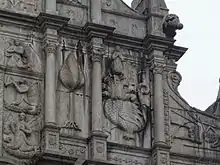
The ruins now consist of the southern stone façade—intricately carved between 1620 and 1627 by Japanese Christians in exile from their homeland and local craftsmen under the direction of Italian Jesuit Carlo Spinola—and the crypts of the Jesuits who established and maintained the church. The façade sits on a small hill, with 68 stone steps leading up to it. The carvings include Jesuit images with Oriental themes, such as The Blessed Virgin Mary stepping on a seven-headed hydra, described in Chinese characters as 'Holy Mother tramples the heads of the dragon'. A few of the other carvings are of the founders of the Jesuit Order, the conquest of Death by Jesus, and at the very top, a dove with wings outstretched.
Conservation
Resisting calls for the dangerously leaning structure to be demolished, from 1990 to 1995, the ruins were excavated under the auspices of the Instituto Cultural de Macau to study its historic past. The crypt and the foundations were uncovered, revealing the architectural plan of the building. Numerous religious artifacts were also found together with the relics of the Chinese Christian martyrs and the monastic clergy, including the founder of the Jesuit college in Macau, Father Alessandro Valignano.
The ruins were restored by the Macanese government into a museum, and the façade is now buttressed with concrete and steel in a way which preserves the aesthetic integrity of the façade. A steel stairway allows tourists to climb up to the top of the façade from the rear.
References
 Media related to Ruins of St. Paul's at Wikimedia Commons
Media related to Ruins of St. Paul's at Wikimedia Commons- 192183185 Ruins of Saint Paul's on OpenStreetMap
Gallery
- Front of the ruins of Saint Paul's:
 The ruins of the original clock tower and cloister were opened into roads.
The ruins of the original clock tower and cloister were opened into roads.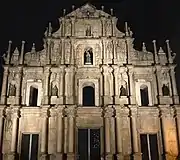 Stone carvings and bronze statues on the archway of the St. Paul's.
Stone carvings and bronze statues on the archway of the St. Paul's.
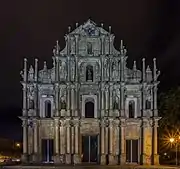


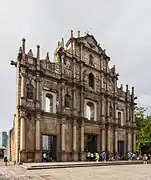
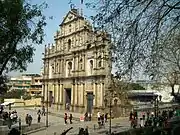 St Paul's Ruins from St Paul's Hill, Macau
St Paul's Ruins from St Paul's Hill, Macau At sunset
At sunset Facade of the Mother-of-God church
Facade of the Mother-of-God church.jpg.webp)
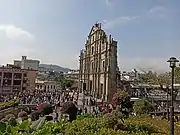
.jpeg.webp)
- Front of the ruins of Saint Paul's with stairs:
.jpg.webp)
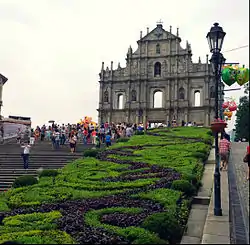 Ruins of St. Paul's Cathedral
Ruins of St. Paul's Cathedral
 Panorama of Ruins of St Paul's from the front of façade.
Panorama of Ruins of St Paul's from the front of façade.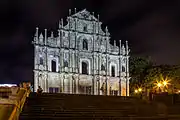
 Remains of the Cathedral of Saint Paul, Macau
Remains of the Cathedral of Saint Paul, Macau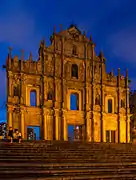 Remains of the Cathedral of Saint Paul, Macau at sunset
Remains of the Cathedral of Saint Paul, Macau at sunset

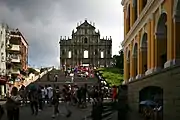


- Back of the ruins of Saint Paul's:
 The back of the Ruins of St. Paul's, behind the façade are remains of the original pillars and a shrine.
The back of the Ruins of St. Paul's, behind the façade are remains of the original pillars and a shrine. The former church room, photographed from the first floor of the facade.
The former church room, photographed from the first floor of the facade. Back of the facade with the stairs for visitors
Back of the facade with the stairs for visitors
.jpg.webp)

- Details
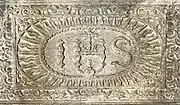 The emblem of the Jesuit Order on the Ruins of the St. Paul.
The emblem of the Jesuit Order on the Ruins of the St. Paul.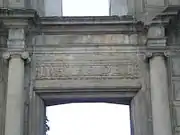 This is the entry of Cathedral of Saint Paul in Macau. "MATER DEI" is engraved on the front door, which means "Mother of God".
This is the entry of Cathedral of Saint Paul in Macau. "MATER DEI" is engraved on the front door, which means "Mother of God". The foundation stone, laid in 1602, under the front wall (i.e. the Archway) of St. Paul’s Church. The inscription "VIRGINI MAGNÆ MATRI CIVITAS MACAENSIS LIBENS POSVIT·AN·1602", which can be interpreted as: "The City of Macau built this Church in honour of the Great Virgin Mother in the year 1602".
The foundation stone, laid in 1602, under the front wall (i.e. the Archway) of St. Paul’s Church. The inscription "VIRGINI MAGNÆ MATRI CIVITAS MACAENSIS LIBENS POSVIT·AN·1602", which can be interpreted as: "The City of Macau built this Church in honour of the Great Virgin Mother in the year 1602".
 Detail from the Saint Paul church ruins in Macau. The carvings include Jesuit images with Oriental themes, such as The Blessed Virgin Mary stepping on a seven-headed hydra, described in Chinese characters as 'Holy Mother tramples the heads of the dragon'.
Detail from the Saint Paul church ruins in Macau. The carvings include Jesuit images with Oriental themes, such as The Blessed Virgin Mary stepping on a seven-headed hydra, described in Chinese characters as 'Holy Mother tramples the heads of the dragon'..jpg.webp)
.jpg.webp)
.jpg.webp)
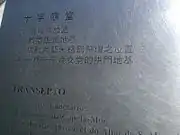
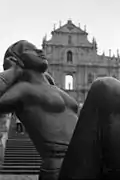






.jpg.webp)
.jpg.webp)
.jpg.webp)
- Sketches and old pictures
 St. Paul’s College and Church before the fire in 1834. It can be seen that most of the buildings of the College and Church, including the bell tower, still exist, painted by George Channery.
St. Paul’s College and Church before the fire in 1834. It can be seen that most of the buildings of the College and Church, including the bell tower, still exist, painted by George Channery. Ruins of the main altar of the church after the fire. Painted by Chanary in 1835.
Ruins of the main altar of the church after the fire. Painted by Chanary in 1835. The St. Paul's archway in 1870, photographed by John Thomson.
The St. Paul's archway in 1870, photographed by John Thomson.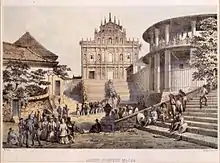 The façade of St. Paul's Church by Wilhelm Heine, 1854
The façade of St. Paul's Church by Wilhelm Heine, 1854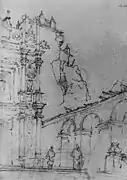 After the Great Fire of 1835, the cloister next to the church survived and the bell tower next to it was badly damaged.
After the Great Fire of 1835, the cloister next to the church survived and the bell tower next to it was badly damaged.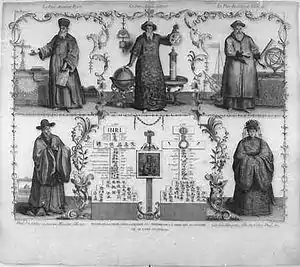 Some scholars who passed through the College: Matteo Ricci (left), Adam Schall (center), Ferdinand Verbiest (right); below Xu Guangqi and his granddaughter Candide Hiu
Some scholars who passed through the College: Matteo Ricci (left), Adam Schall (center), Ferdinand Verbiest (right); below Xu Guangqi and his granddaughter Candide Hiu Jesuit missionary Ferdinand Verbiest. This is an enlargement of a part of the image that is to the left.
Jesuit missionary Ferdinand Verbiest. This is an enlargement of a part of the image that is to the left.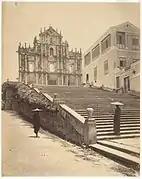 1869
1869 1 October 1908
1 October 1908 1854
1854
- Miscellaneous:
 The ruins of the main altar no longer exist and are now the Museum of Sacred Art and Crypt
The ruins of the main altar no longer exist and are now the Museum of Sacred Art and Crypt Entrance to the museum
Entrance to the museum The original Inner Harbor view on the St. Paul's archway is obscured by modern buildings, and the statue of Matteo Ricci is on the lower right.
The original Inner Harbor view on the St. Paul's archway is obscured by modern buildings, and the statue of Matteo Ricci is on the lower right.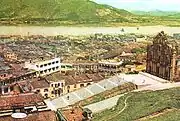 Looking at the ruins of St. Paul's Cathedral, St. Paul’s archway, stone steps and inner harbor from the Fortress in 1955
Looking at the ruins of St. Paul's Cathedral, St. Paul’s archway, stone steps and inner harbor from the Fortress in 1955